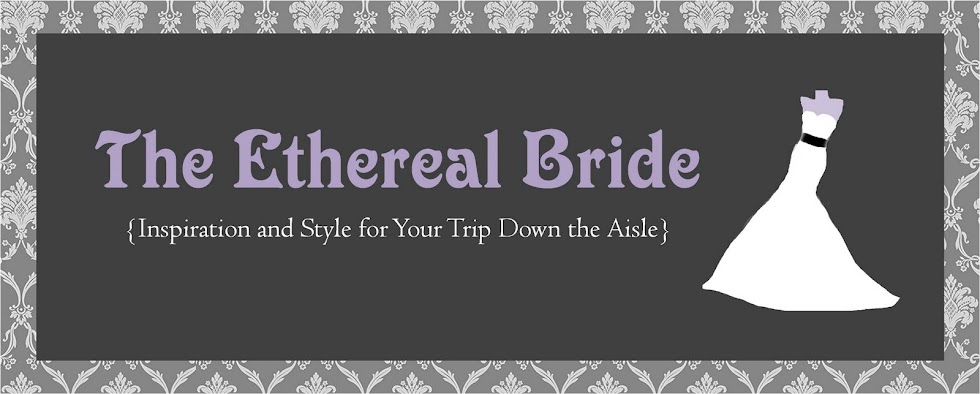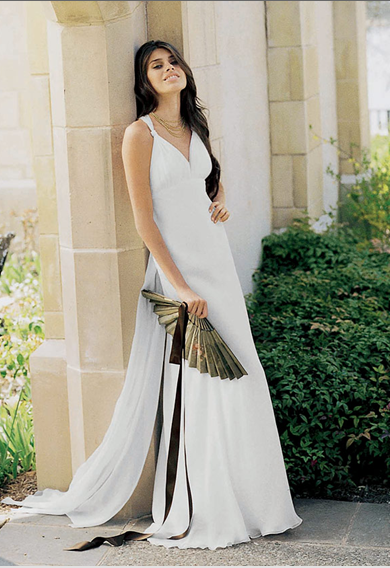This was originally posted on May 19, 2010.
It's very important (in my opinion anyways) to know at least a little bit about fabric before you go shopping for wedding gowns/ maids dresses/ mom's dresses etc. Most assume that the price of a dress is mainly based on the how much detail it has (embroidery, beading) but that's not totally true. Fabric actually has a much greater impact on the price of a dress. Because most dresses are made by machine in far away places like Taiwan or China, they really don't cost very much to make because the labor costs are (sadly) so cheap. The materials, along with the complexity of the design, are actually what really drive the cost up. A dress that is made of polyester satin and covered in embroidery and beadwork will still most likely be less expensive than a dress made of silk satin with no embroidery or beadwork because silk satin is really expensive. There are pros and cons to different types of fabric, so it really just depends on what your looking for and how much you want to spend. Being a fabric junkie (design school will do that to you), I am partial to richer fabrics but everyone is different. So, here is The Ethereal Bride's handy fabric guide to hopefully help you make sense of the big sea of white that lays before you.
First of all, there are two aspects of fabric that you need to understand- how it's made and what it's made of. How it's made refers to whether or not it's knit or woven and what type of knit or weave it is. Typically, most special occasion fabrics are woven, except for some stretch jersey, so I'll just focus on those. The way a fabric is woven determines how it feels to the touch and how it flows on the body. Some examples of different types of weaves are satin, taffeta, and organza. What it's made of refers to what type of fibers were used to make the fabric. Some examples are cotton, silk, acetate, linen, and polyester. Sometimes a combination of fibers is used such as a silk/cotton blend. Below, I will discuss the most common bridal fabrics in greater detail.
Polyester Satin
Most people have horrible 1970's flashbacks when they think of polyester, but it's actually super versatile and probably the most common fabric used in the bridal industry. Shocking, I know. Poly satin is a super common satin because it looks very similar to silk satin but is way less expensive, more wrinkle resistant, and way less delicate. Keep in mind, there are many different quality levels of poly satin. There is definitely a difference between a $99 poly satin gown and a $1900 one.
Pros: Less expensive than silk, more wrinkle resistant than natural fabrics, comes in any color, durable
Cons: Not as rich looking or feeling as silk satin, heavy and can be hot to wear
Best time of year to wear: Fall, winter or spring, however, it can definitely be worn in summer,too, just note that you may get overheated during an outdoor ceremony or photos.
Polyester satin gown by Allure Bridals; style# 8759
Polyester Chiffon
Like poly satin, poly chiffon is the most common type of chiffon in the bridal market. It is characterized by it's sheer, flowy look.
Pros: Less expensive than silk chiffon, lightweight, comes in any color
Cons: Wrinkles easily but not as easily as silk, delicate
Best time to wear: During warmer weather months
Polyester chiffon gown by David's Bridal; style# 9743
Taffeta
Taffeta is often made of a number of different fibers- nylon, acetate, silk or polyester. It is characterized by it's swishy and sometimes wrinkled texture. The stiffer the taffeta, the better the quality. To test the quality, scrunch a handful of the fabric, if it stays somewhat scrunched then it is good quality, if it springs back to being flat, then it is of lesser quality. Unlike other synthetic fabrics, certain synthetic taffetas are sometimes even better quality than silk taffeta, such as the Enzoani style featured below, which is nylon.
Pros: Lightweight, looks good if it's a little wrinkled, can come in any color, durable, synthetic varieties can be less expensive than silk (but not always), because of the way it's woven it can come in iridescent (almost two tone) colors
Cons: Not as lustrous as satin, some don't like the "swish" sound it makes
Best time of year to wear: Taffeta is perfect anytime of year because it's rich enough for winter months but lightweight enough for the hottest months
Iridescent crinkle taffeta dress by Bari Jay; style# 933
Nylon taffeta gown by Enzoani; style "Brie"
Silk taffeta gown by Jasmine Couture; style# T939
Silk Satin
Silk satin (sometimes referred to as peau de soie or duchesse) is probably the richest fabrics due to it's lustrous appearance and buttery soft feel. Unfortunately, it is also one of the most expensive. Just to give you a little perspective of just expensive silk satin is- at my local fabric retailer silk taffeta costs $25 per yard whereas the silk satin costs $75 per yard. However, in my esteemed opinion, it's worth every penny.
Pros: Very luxurious look and feel, much more lightweight than poly satin
Cons: Very expensive, not as durable as poly satin, heavier than some other fabrics, like all silk fabrics it can't come in stark white because silk can't be safely bleached without ruining the integrity of the fabric
Best time of year to wear: Probably best in cooler months but can be worn anytime of year, just be aware that you may become overheated during outdoor summer ceremonies
Silk duchesse satin gown by St. Pucchi; style# 9322
Silk Organza
Organza is basically a stiffer chiffon; it is just as sheer but not flowy. It also comes in poly or nylon, but I am only going to talk about silk organza because it is more common and many of the properties are similar anyways.
Pros: Luxurious, lightweight,
Cons: Wrinkles easily, delicate, expensive but not as expensive as silk satin
Best time of year to wear: Typically during warmer months, however, can easily be worn anytime of year
Silk organza gown by James Clifford; style# J11009S
Dupioni Silk & Silk Shantung
Dupioni silk and silk shantung are very similar fabrics, so I'm just going to lump them together. They are both a plain weave using raw silk yarns (other silk fabrics' yarns are processed to give them their smooth texture), the only difference between the two is that the yarns used in dupioni silk are "slubbed", which means the yarn's thickness is inconsistant, creating a uniquely textured fabric.
Pros: Fairly lightweight, rich look and feel, comes in lots of gorgeous bright colors, maintains volume without lots of crinolines underneath
Cons: Wrinkles pretty easily, expensive, some don't like the "raw" texture
Best time of year to wear: Anytime of year because it is lightweight enough for warm months but rich enough for cold months
Verbena silk shantung dress by Watters; style# 4912
Midori dupioni silk dress by Watters; style# 6456
Silk Charmeuse
Silk charmeuse, also sometimes referred to as "crepe backed satin", is a form of silk satin but is super thin and flowy. It is primarily used in body conscious styles with lots of draping.
Pros: Super luxurious feel and look, less expensive than silk satin, drapes and flows really easily
Cons: Very delicate, more expensive than synthetic fabrics,
Best time of year to wear: Warmer months but can work during cold months because of it's rich appearance
Silk charmeuse gown by Vera Wang; style "Cassandra"
Silk charmeuse dress by Melissa Sweet; style# MS321
Tulle
Most people know tulle as the fabric commonly used in tutus, but it is also used in wedding gowns as well. It is characterized by it's stiffness, sheerness, and ability to create really full skirts. It is typically made of nylon but can also made of silk.
Pros: Lightweight, fairly inexpensive, hides wrinkles fairly well
Cons: Delicate, too poofy for some tastes, not as rich looking as other fabrics
Best time of year to wear: Anytime of year
Flower girl dress with tulle skirt by Johanna Grace; style# "Arabesque"
Tulle gown by Impression; style# 3073
Silk Chiffon
Silk chiffon (also known as silk mousseline or silk crinkle chiffon) is very similar to synthetic chiffon. It is sheer and very lightweight.
Pros: Lightweight, soft texture
Cons: Very delicate, expensive, some don't like it's raw texture
Best time of year to wear: Warm months
Silk mousseline dress by Watters; style# 4017B
{Images via their respective websites}
Want to know what the deal is with other fabrics that I didn't mention?? Ask me in the comments section below!!
















Hi! Great post. My head has been spinning lately with fabrics. I really dig a Lazaro gown (3018) that I tried on, but I snuck a look at the tag and found that "silk faced satin" means "15% silk plus mostly polyester and some acetate." I hardly wear polyester except for workout clothes and some undergarments, so I'm having a hard time reconciling that with a $3750 gown...I kind of expected it to be all silk. Would you explain to me why a designer would use this fabric (since I see "silk faced" tossed around a lot) and if it's typical for a gown that pricey to have polyester in it. Lazaro has a gown (3956) that's marginally more expensive ($4290) made of silk radzmir. I just need the difference explained to feel ok with buying this gown. Any light you can shed would be very much appreciated. Thank you!
ReplyDeleteHi Lillian-
ReplyDelete"Silk faced satin" doesn't necessarily refer to the fabric's content, it is actually referring to how the fabric is woven, so that Lazaro gown could very well be 100% silk. If it does have polyester content, it is probably because it acts as a stabilizer making it more durable and allowing it to lay correctly on the body. Keep in mind that the polyester used in workout wear is of much different quality than bridal poly (just like there's a huge difference between a Chevrolet and a Porsche, even though they're both cars). However, knowing Lazaro, I would assume that the gown is 100% silk. Your best bet would be to call a retailer that carries Lazaro and ask what it's fabric content is and then go see and feel it in person. Hope this helps!!